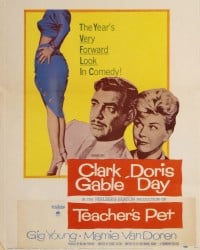These bright comedies provide some harmless laughs in the twilight of the career of “The King of Hollywood.”
Two years, 1958 and 1959. Two films, Teacher’s Pet and But Not for Me. Two actresses, Doris Day and Carroll Baker. A third actress, Lilli Palmer, in the wings. All compete for the affections of one actor, Clark Gable. In these films, the age difference between Gable and his co-stars was nothing new, except in the beginning of his career when his two most frequent screen lovers, Joan Crawford and Jean Harlow, were “only” three and ten years younger, respectively. Even in his most famous film, Gone With the Wind, Vivien Leigh was thirteen years his junior.
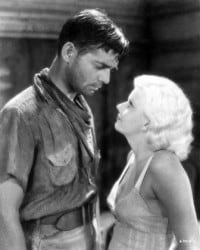 In the 1932 Red Dust, Gable as a rubber plantation owner in French Indochina was romancing both Harlow and Mary Actor. When the film was remade twenty-one years later as Mogambo, much was made of his durability as a screen lover, for he, now fifty-two and a Great White Hunter in Africa, remained. The ladies, however, had been replaced by Ava Gardner and Grace Kelly, both half his age.
In the 1932 Red Dust, Gable as a rubber plantation owner in French Indochina was romancing both Harlow and Mary Actor. When the film was remade twenty-one years later as Mogambo, much was made of his durability as a screen lover, for he, now fifty-two and a Great White Hunter in Africa, remained. The ladies, however, had been replaced by Ava Gardner and Grace Kelly, both half his age.
After Mogambo, the age gap between Gable and the ladies continued, only more ridiculously so. He had grown older while his co-stars were the same ages as before, sometimes even younger. Occasionally, because of the added spread in both age and waistline, the romantic chemistry failed to ignite. Born in 1901, Gable was now starring opposite Susan Hayward in Soldier of Fortune, Jane Russell in The Tall Men (both 1955), Yvonne De Carlo in Band of Angels (1957), Sophia Loren in It Started in Naples (1960) and Marilyn Monroe in The Misfits (1961), his last film.
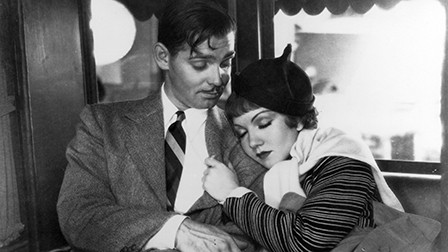 In both Teacher’s Pet and But Not for Me, the actor’s fourth- and third-to-last films, the Gable magic still works—and works well—because these are comedies, and his gift for comedy had been well established in It Happened One Night (1934) with Claudette Colbert, born in 1903. Especially in But Not for Me, the age issue with the thirty-year-younger Carroll Baker is part of the plot, even made fun of by Gable’s character, who, in the end, decides she is too young for him—no, more accurately, he is too old for her.
In both Teacher’s Pet and But Not for Me, the actor’s fourth- and third-to-last films, the Gable magic still works—and works well—because these are comedies, and his gift for comedy had been well established in It Happened One Night (1934) with Claudette Colbert, born in 1903. Especially in But Not for Me, the age issue with the thirty-year-younger Carroll Baker is part of the plot, even made fun of by Gable’s character, who, in the end, decides she is too young for him—no, more accurately, he is too old for her.
But bits of plot are slipping in prematurely. . . .
Teacher’s Pet is noticeably better than But Not for Me, mainly because of the strength of Doris Day, whose comic flair, largely and appropriately suppressed somewhat here, would shortly launch a series of famous comedies that would extend her movie career another ten years: It Happened to Jane, Pillow Talk (both 1959), Please Don’t Eat the Daises (1960), That Touch of Mink (1962), Move Over, Darling (1963), Send Me No Flowers (1964) and many others. Her leading men would include Jack Lemmon, David Niven, Cary Grant, James Garner and, most frequently, Rock Hudson.
Even more than Day, the success of Teacher’s Pet belongs to Gig Young as her brainy psychologist boyfriend. In one of his best scenes, Young becomes heavily intoxicated after a drinking contest with Gable at a nightclub when he bragged he could imbibe all he wished without any ill effects. Clearly the best performance in the film, it earned Young an Oscar nomination for Best Supporting Actor.
 Teacher’s Pet begins when journalism professor Erica Stone (Day) asks a city newspaperman, James Gannon (Gable), to speak to her class. In a nasty letter, he turns down her offer. Forced to accept by his managing editor, Gannon arrives in class as a Jim Gallagher, since Erica has never seen Gannon. Despite arriving late, he immediately proceeds to correct her attribution of a quote. Immediately as well, they are on a wrong footing, not to last long, however.
Teacher’s Pet begins when journalism professor Erica Stone (Day) asks a city newspaperman, James Gannon (Gable), to speak to her class. In a nasty letter, he turns down her offer. Forced to accept by his managing editor, Gannon arrives in class as a Jim Gallagher, since Erica has never seen Gannon. Despite arriving late, he immediately proceeds to correct her attribution of a quote. Immediately as well, they are on a wrong footing, not to last long, however.
In his growing relationship with Erica, Gallagher discovers he has to compete with her boyfriend, Dr. Hugo Pine (Young), who succumbs to his first hangover. “To me,” he muses, “journalism is, ah, like a hangover—you can read about it for years, but until you’ve actually experienced it, you have no conception of what it’s really like.”
 And in Erica’s own feelings for this student who shows a knack for journalistic writing, she sees Gallagher’s current girlfriend, a nightclub singer (Mamie Van Doren), not as a threat, but as a source of amusement—at Gallagher’s embarrassment when Peggy sings a gyrating, hip-swinging version of “The Girl Who Invented Rock and Roll.”
And in Erica’s own feelings for this student who shows a knack for journalistic writing, she sees Gallagher’s current girlfriend, a nightclub singer (Mamie Van Doren), not as a threat, but as a source of amusement—at Gallagher’s embarrassment when Peggy sings a gyrating, hip-swinging version of “The Girl Who Invented Rock and Roll.”
After Erica’s discovery of Gallagher’s identity and the expected ill feelings, Pine, who seems more in love with psychology than with Erica, persuades her to give Gannon another chance. Although coming from different schools of journalism—Erica believing in the strict rules of Who, What, Why, When, Where and How, he self-educated in the school of hard knocks—they come to appreciate each other’s viewpoints and style.
The whole movie is predictable and the plot familiar, but the stars clearly respond to the excellent script (by husband-and-wife team, Fay and Michael Kanin, Oscar-nominated for their screenplay) and deliver the abundant laughs with sincerity, even flair. With a certain grace and dignity always intact, both as actor and as Gannon/Gallagher, Gable holds his own against this youngster Day—and, yes, brings forth that old magic, naturally and without any self-consciousness, considering the silliness of the plot.
 Two of the noteworthy supporting players include Nick Adams, a copy boy who worships Gannon, and a player in 350-plus films and TV shows, Charles Lane, a fellow journalist, who perhaps senses Gannon’s attraction to Erica before even he does. Lost among the uncredited players are Jack Albertson and Cyril Delevanti.
Two of the noteworthy supporting players include Nick Adams, a copy boy who worships Gannon, and a player in 350-plus films and TV shows, Charles Lane, a fellow journalist, who perhaps senses Gannon’s attraction to Erica before even he does. Lost among the uncredited players are Jack Albertson and Cyril Delevanti.
Directed by George Seaton, who had Oscar wins for Miracle on 34th Street (1947) and The Country Girl (1954), the movie was filmed in VistaVision and scored by Roy Webb.
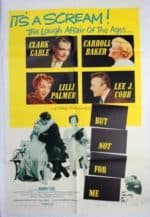 If Gig Young makes Teacher’s Pet something special, above the ordinary, and Doris Day gives it an extra sparkle, then, in a negative reversal, a lackluster Barry Coe is the weak link in the cast of But Not for Me. And if Carroll Baker hasn’t matured as an actress all that much after her previous three films, Giant, Baby Doll (both 1956) and The Big Country (1958), she at least seems more at ease here, in a simpler role, with fewer challenges and nuances to negotiate. By contrast, well-established actress Lilli Palmer glides through her scenes, seeming to arrive and depart like a fresh breeze, deliciously scented and bracing.
If Gig Young makes Teacher’s Pet something special, above the ordinary, and Doris Day gives it an extra sparkle, then, in a negative reversal, a lackluster Barry Coe is the weak link in the cast of But Not for Me. And if Carroll Baker hasn’t matured as an actress all that much after her previous three films, Giant, Baby Doll (both 1956) and The Big Country (1958), she at least seems more at ease here, in a simpler role, with fewer challenges and nuances to negotiate. By contrast, well-established actress Lilli Palmer glides through her scenes, seeming to arrive and depart like a fresh breeze, deliciously scented and bracing.
Clark Gable as newspaper man James Gannon in Teacher’s Pet is too self-confident to worry about the problems of age. In But Not for Me, however, the actor, now as Russ Ward, a Broadway producer, has a real problem with that subject. It might be said that his age disparity with all those past young ladies is now written into a script, front and center, on the screen for all to see.
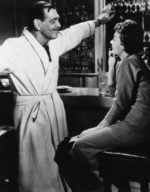 For age and aging are much on Russ’ mind. He is always looking in the mirror, sucking in his stomach and lying about his age, taking off as much as ten years. Why the concern is uncertain—he’s reasonably successful in what he does, his ex-wife wife, Kathryn (Palmer), seems to be at bay and he has no interest in his secretary and student actress, Ellie (Baker), though the screen reveals all too clearly that she’s foolishly in love with him.
For age and aging are much on Russ’ mind. He is always looking in the mirror, sucking in his stomach and lying about his age, taking off as much as ten years. Why the concern is uncertain—he’s reasonably successful in what he does, his ex-wife wife, Kathryn (Palmer), seems to be at bay and he has no interest in his secretary and student actress, Ellie (Baker), though the screen reveals all too clearly that she’s foolishly in love with him.
Russ is preparing to mount a new play, Give Me Your Hand, and the hard-drinking playwright, Jeremiah MacDonald (Lee J. Cobb, less outré here than usual), says he’s washed up. The play, about a middle-aged man pursuing a young woman, isn’t coming together. But when Ellie proposes marriage, Russ has an idea. Why not reverse the plot of the play—have a young woman pursue a middle-aged man? Using lines from Ellie’s own love confession, Russ feeds them to MacDonald as if they were his ideas. MacDonald does a rewrite and the play is magically improved.
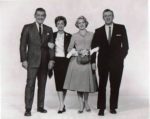 Those involved in the play’s production gather at Kathryn’s Long Island mansion to rehearse. A banker (Thomas Gomez) wants in on the deal, but Russ’ business manager (Charles Lane, held over from Teacher’s Pet) says the play has an anonymous backer.
Those involved in the play’s production gather at Kathryn’s Long Island mansion to rehearse. A banker (Thomas Gomez) wants in on the deal, but Russ’ business manager (Charles Lane, held over from Teacher’s Pet) says the play has an anonymous backer.
When Ellie reads the part of the young woman, everyone agrees she’s perfect for the role. A young acting student, Gordon Reynolds (Coe) assumes the male lead. He is smitten with Ellie, but for the time being she has another priority. Russ hasn’t discouraged her. Perhaps, he reasons, he’s not too old after all.
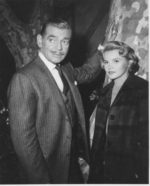 After the play makes a big hit on Broadway, Russ sees what he’s given up in Kathryn as well as the impracticality of his relations with Ellie. Then, come to find out, Ellie has married Gordon. Just when it seems all is resolved, complications arise. Ellie discovers her new husband wants to give up the theater and move to Montana. She goes to Russ’ apartment and hops in his bed, hoping Gordon will walk in and demand an annulment, but, in the end, the newlyweds compromise.
After the play makes a big hit on Broadway, Russ sees what he’s given up in Kathryn as well as the impracticality of his relations with Ellie. Then, come to find out, Ellie has married Gordon. Just when it seems all is resolved, complications arise. Ellie discovers her new husband wants to give up the theater and move to Montana. She goes to Russ’ apartment and hops in his bed, hoping Gordon will walk in and demand an annulment, but, in the end, the newlyweds compromise.
So what about that other couple?— Oh, yes. Over drinks at the bar in his apartment, Russ and Kathryn agree to give their relationship another chance. After all, the play they’ve put on is titled Give Me Your Hand, so Russ takes Kathryn’s. Besides rediscovering his ex-wife’s many good qualities, turns out she was the anonymous backer of the play.
 Among those ten variable films that followed Mogambo in 1953, amid all the misfires—It Happened in Naples, for example—and beyond the occasional effective comedies, one film emerges as the most outstanding, Run Silent, Run Deep(1958), one of the best of the World War II-set submarine movies.
Among those ten variable films that followed Mogambo in 1953, amid all the misfires—It Happened in Naples, for example—and beyond the occasional effective comedies, one film emerges as the most outstanding, Run Silent, Run Deep(1958), one of the best of the World War II-set submarine movies.
Even on this set Gable’s age was an issue—his headaches, a visibly shaking head in some scenes and his request to end filming by five p.m., as by that time, he said, he was “tired.” Burt Lancaster, his naval subordinate throughout most of the plot, made fun of the actor’s age, but at least here, in an all-male cast, there were no sweet young things for Gable to romance—and take the risk of appearing ridiculous.
